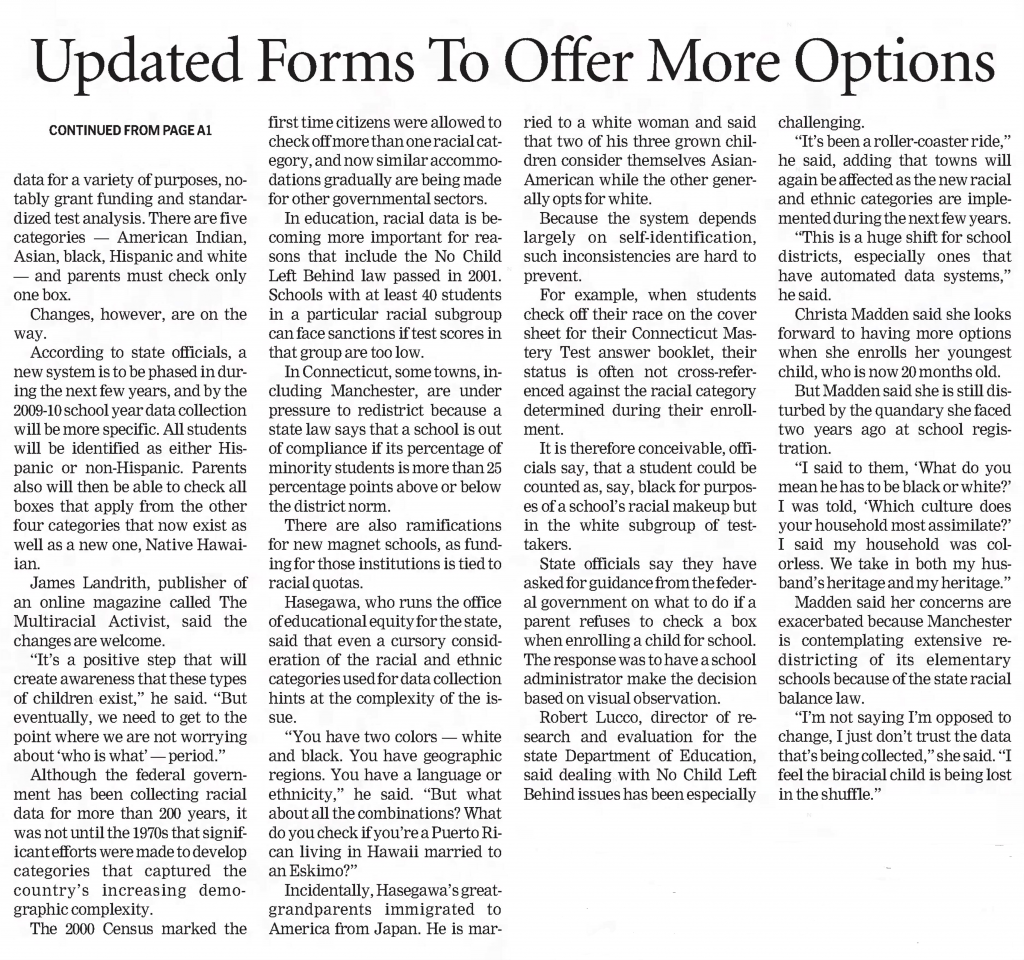March 20, 2006
By JIM FARRELL, Courant Staff Writer
Christa Madden is white and her husband Darryl is black but their two children have to be, well, one or the other.
That’s what Madden learned when she signed up her oldest child for kindergarten two years ago and was told she had to “check one box” on a form asking about racial identity.
“I was stunned, totally dumbfounded,” said Madden, who lives in Manchester. “Check one or the other? What happened to cultural sensitivity? I mean, come on – especially in the education field.”
The subject of racial identification garnered attention last week when the principal of a Hartford magnet school acknowledged changing the racial designation of select biracial students in what some parents say was an effort to inflate the white population at the school. The principal said he was simply correcting errors.
For many education officials – and parents such as the Maddens – the case has renewed longstanding frustrations with what they consider an inflexible system that has implications for test scores, racial balance and magnet schools.
“It’s just endlessly confusing,” said Jack Hasegawa of the state Department of Education.
The U.S. Department of Education requires states to collect race and ethnicity data for a variety of purposes, notably grant funding and standardized test analysis. There are five categories – American Indian, Asian, black, Hispanic and white – and parents must check only one box.
Changes, however, are on the way.
According to state officials, a new system is to be phased in during the next few years, and by the 2009-10 school year data collection will be more specific. All students will be identified as either Hispanic or non-Hispanic. Parents also will then be able to check all boxes that apply from the other four categories that now exist as well as a new one, Native Hawaiian.
James Landrith, publisher of an online magazine called The Multiracial Activist, said the changes are welcome.
“It’s a positive step that will create awareness that these types of children exist,” he said. “But eventually, we need to get to the point where we are not worrying about `who is what’ – period.”
Although the federal government has been collecting racial data for more than 200 years, it was not until the 1970s that significant efforts were made to develop categories that captured the country’s increasing demographic complexity.
The 2000 Census marked the first time citizens were allowed to check off more than one racial category, and now similar accommodations gradually are being made for other governmental sectors.
In education, racial data is becoming more important for reasons that include the No Child Left Behind law passed in 2001. Schools with at least 40 students in a particular racial subgroup can face sanctions if test scores in that group are too low.
In Connecticut, some towns, including Manchester, are under pressure to redistrict because a state law says that a school is out of compliance if its percentage of minority students is more than 25 percentage points above or below the district norm.
There are also ramifications for new magnet schools, as funding for those institutions is tied to racial quotas.
Hasegawa, who runs the office of educational equity for the state, said that even a cursory consideration of the racial and ethnic categories used for data collection hints at the complexity of the issue.
“You have two colors – white and black. You have geographic regions. You have a language or ethnicity,” he said. “But what about all the combinations? What do you check if you’re a Puerto Rican living in Hawaii married to an Eskimo?”
Incidentally, Hasegawa’s great-grandparents immigrated to America from Japan. He is married to a white woman and said that two of his three grown children consider themselves Asian-American while the other generally opts for white.
Because the system depends largely on self-identification, such inconsistencies are hard to prevent.
For example, when students check off their race on the cover sheet for their Connecticut Mastery Test answer booklet, their status is often not cross-referenced against the racial category determined during their enrollment.
It is therefore conceivable, officials say, that a student could be counted as, say, black for purposes of a school’s racial makeup but in the white subgroup of test-takers.
State officials say they have asked for guidance from the federal government on what to do if a parent refuses to check a box when enrolling a child for school. The response was to have a school administrator make the decision based on visual observation.
Robert Lucco, director of research and evaluation for the state Department of Education, said dealing with No Child Left Behind issues has been especially challenging.
“It’s been a roller-coaster ride,” he said, adding that towns will again be affected as the new racial and ethnic categories are implemented during the next few years.
“This is a huge shift for school districts, especially ones that have automated data systems,” he said.
Christa Madden said she looks forward to having more options when she enrolls her youngest child, who is now 20 months old.
But Madden said she is still disturbed by the quandary she faced two years ago at school registration.
“I said to them, `What do you mean he has to be black or white?’ I was told, `Which culture does your household most assimilate?’ I said my household was colorless. We take in both my husband’s heritage and my heritage.”
Madden said her concerns are exacerbated because Manchester is contemplating extensive redistricting of its elementary schools because of the state racial balance law.
“I’m not saying I’m opposed to change, I just don’t trust the data that’s being collected,” she said. “I feel the biracial child is being lost in the shuffle.”
Copyright 2006 Hartford Courant



